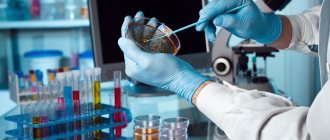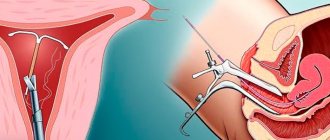General information about the procedure
Removal of benign formations is the main principle of treatment, preventing the likelihood of growths transforming into a malignant form. Various techniques are used to eliminate polyps in the uterus. This:
- Drug therapy using hormonal drugs, antibiotics and progesterone-containing agents. This method is effective only at the initial stage of polyp formation, not exceeding 10 mm in size.
- Polypectomy. The polyp is removed by scraping or unscrewing. The operation is performed under local anesthesia.
- Hysteroscopy. This is a minimally invasive method by which the polyp is removed without damaging the internal tissues of the uterus. The use of microsurgical instruments, in particular an endoscope with a microscopic camera, allows not only to remove the polyp, but also to perform vascular coagulation. This prevents the possibility of bleeding from a damaged vessel.
Polypectomy is used to remove polyps.
After one of the methods for eliminating the growth, a course of restorative treatment becomes mandatory, including the use of antibiotics, regardless of the reason that provoked the formation of polyps.
A normal physiological manifestation after the removal of a benign growth is the appearance of spotting bloody discharge. Intense discharge, accompanied by pain in the lower abdomen, becomes an indication for an immediate visit to the gynecologist. This will prevent the development of serious complications.
Discharge after polyp removal
The duration of discharge depends on the size of the surgical procedure and the extent of the affected endometrium. A less traumatic endoscopic method that prevents recurrence of polyps is hysteroscopy.
Removal of the formation occurs with simultaneous coagulation of the damaged vessel to avoid profuse bleeding from the leg of the polyp.
If a large polyp forms in the cervical canal during pregnancy, it can threaten dangerous infection of the fetus. A course of antibiotic therapy may be necessary.
What influences the appearance
The occurrence of leucorrhoea mixed with blood in the early postoperative period is a physiological norm. Depending on the quality of the discharge, the doctor and the woman herself evaluate the success of wound healing. Factors that determine the consistency, composition and abundance of discharge after surgery:
- Coagulability level. Regulated by the number of platelets in the blood. An analysis that determines this indicator must be carried out before surgery.
- Polyp root size. The depth of rooting of a wide or thin elongated stalk into the endometrial mucosa.
- Location of the formation in the uterus or cervical canal. It is more difficult to remove multiple uterine polyps without damaging the vessels.
Features and norms of discharge in the postoperative period
Discharge after removal of a uterine polyp is not a deviation from the norm. However, they should be insignificant and cause the need to replace the pad no more than 2 times a day. Their intensity is more pronounced for no more than 3 days.
How long the discharge lasts after the elimination of growths depends on many factors, namely:
- the size of the neoplasm and the size of its root;
- blood clotting level;
- the depth of penetration of the polyp stalk into the endometrial mucosa;
- localization of the growth in the cervical canal or uterus;
- the formation of a hematometra, which prevents the removal of bloody discharge and provokes the possibility of infection.
The duration, quantity and quality of discharge are an important indicator of the success of the healing process. Therefore, it is important to know how to assess the nature of the discharge in the first days after the elimination of neoplasms.
Types of discharge
Discharge after hysterectomy of a polyp or polytomy is varied. They are represented by 4 main types:
- Physiological. This is the presence of discharge that does not exceed the norm. As the wound heals, they decrease in size. When performing a minimally invasive operation, they last no more than 1 – 2 days. During the day, the amount of discharge is about 50 ml. The consistency of the discharge is liquid, the color is transparent or pale pink. Their cessation indicates normal healing.
- Bleeding. Excision of a polyp may be accompanied by damage to large vessels located on the cervix, so bright red blood may flow from the wound. Dark clots may appear. If red blood continues for more than 3 days, you should consult a doctor.
- Purulent discharge. A discharge of a yellowish or greenish tint, characterized by a heavy odor, indicates the development of an infectious process caused by pathogens of sexually transmitted diseases - staphylococcus or streptococcus.
- Putrid discharge. They are a consequence of the penetration of clostridia into the cervix, causing an infection of a putrefactive nature. The discharged liquid smells foul and foams. The patient experiences acute pain in the lower abdomen. The situation requires immediate action to correct the condition.
The appearance of purulent or putrefactive discharge should be a reason for mandatory contact with a gynecologist. Otherwise, the risk of developing serious complications increases - infertility, sepsis, peritonitis.
Volume
For planned tumor removal, experts recommend performing the procedure after the first half of the menstrual cycle. This significantly reduces the likelihood of heavy and prolonged discharge due to the intensity of the recovery process.
The daily volume of fluid released in the first three days is up to 50 ml. From 4 to 7 days, it is possible to secrete no more than 10 ml of ichor.
Duration
The duration of bleeding is determined by the surgical method used. The most aggressive is considered to be curettage, caused by the need to remove multiple polyps.
Obstruction of the process of tissue regeneration and provocation of prolonged bleeding occurs in the following situations:
- after removal of polyps of the cervical canal (it can be damaged by surgical instruments);
- the presence of an inflammatory process or infection in the internal or external genital area preceding the operation;
- curettage with deep removal of the endometrial layer.
A less gentle method, which eliminates injury to the uterine mucosa and, as a result, prevents heavy and prolonged discharge, is vacuum removal of growths. The disadvantage of this method is frequent relapses of polyp formation.
In what cases should you consult a doctor?
Vaginal blood secretion is not always evidence of normality. A change in its consistency, deterioration in well-being and severe abdominal pain are symptoms that warrant a visit to the doctor. Let's consider several pathological types of discharge that may occur after the intervention:
- Bloody, lasting more than 3 days. An abnormal sign will be the presence of clots in the liquid secretion. After hysteroscopy with curettage, discharge is allowed for up to 5 days, but a tendency towards a decrease in the amount of secretion and a gradual change in its color to brownish or yellowish should be monitored. A woman should be wary of the appearance of repeated bleeding. This condition is life-threatening.
- After hysteroscopy, there may be a yellow discharge with a fishy odor. Normally, they appear odorless on the 2-3rd day of intervention and disappear after a week. If a woman notices abdominal pain and profuse, foul-smelling discharge, then this is a reason for concern. Symptoms indicate that an infectious complication has begun in the body.
- Purulent secretion. This type is pathological regardless of the time of appearance and duration. Pus after hysteroresectoscopy in vaginal discharge is a sure symptom of inflammatory diseases, accompanied by acute pain in the lower abdomen and hyperthermia.
Additional signs that require an urgent visit to a specialist include:
- spotting after bleeding lasting more than 1 week;
- fatigue;
- raising the mark on the thermometer;
- release of blood clots from the vagina.
Brown smear mixed with pus is a sign of endometritis, which develops as a result of bacterial agents entering the uterine tissue. If intervention is not timely, bacterial complications can cause abscess or sepsis of the reproductive organ.
A dangerous symptom that requires calling an ambulance is heavy bleeding from the genitals. It develops due to improper pumping of air or medical solution into the uterine cavity. Untimely intervention threatens the woman with death.
Pathological discharge in the postoperative period
They can be caused by several factors and cause complications.
For example, during the first sexual intercourse after the procedure for removing polyps, bleeding may occur. If it does not stop within a few hours, you should visit a gynecologist. To avoid such manifestations, it is recommended to resume intimate relationships only after the complete cessation of discharge of any nature.
The first sexual intercourse after removal of a uterine polyp may cause discharge
A predisposition to constipation due to dysbacteriosis can also lead to bleeding due to the pressure generated on the pelvic floor during straining.
Even failure to comply with personal hygiene rules can cause the discharge to recur. Such situations lead to complications such as:
- penetration of a staphylococcal infection into the uterus provokes an inflammatory process, accompanied by the release of a foul-smelling dark brown liquid;
- ignoring the treatment of sexually transmitted diseases leads to inflammation of the endometrium, appendages and adnexitis, resulting in the appearance of greenish discharge with a foamy consistency, threatening the development of sepsis;
- penetration of Pseudomonas aeruginosa into a fresh wound provokes putrefactive damage to organ tissue and leads to necrosis.
It is possible to exclude the appearance of pathological discharge provided that all doctor’s instructions are followed in the postoperative period.
Features of therapy
If a woman has had a uterine polyp removed, no special treatment is expected to stop the discharge. Bloody fluid discharged due to the normal physiological process of healing and cleansing of the uterine cavity is a sign of recovery. Therefore, you should not try to stop this discharge on your own using blood clotting medications. If necessary, a course of therapy will be prescribed by a specialist.
The absence of complications requires the appointment of a short course:
- anti-inflammatory drugs;
- antispasmodics;
- antibiotics to prevent infection;
- hormonal drugs to stabilize the functioning of the ovaries;
- painkillers (if the patient complains of pain).
All appointments are made depending on the patient’s condition. Rapid rehabilitation will be facilitated by strict adherence to the instructions of the attending physician regarding the dosage, frequency and duration of taking medications.
Prevention of complications
Preventive measures are quite simple. Their main goal is to prevent the development of complications and the likelihood of relapses. Gynecologists recommend:
- follow a gentle regime in the first days after removal of polyps;
- exclude intimacy until the discharge completely stops;
- do not lift heavy objects;
- monitor the nature of the discharge;
- avoid stress.
Taking vitamin complexes, daily exposure to fresh air, proper nutrition are important components of the prevention of any diseases. The formation of uterine polyps is no exception.
Menstruation after polyp removal
An important indicator of recovery after removal of uterine polyps is the normalization of the menstrual cycle. It recovers gradually due to stress and changes in the structure of the endometrium. Regularity and complete restoration of menstruation occurs after 4–5 months.
Changes are observed in the intensity, duration and volume of discharge. They may be more scarce or excessively abundant.
Menstruation after removal of a uterine polyp may be more abundant or scanty.
Warning should be caused by discharge that is abundant and lasts up to 10 days. Associated symptoms are pain in the lower abdomen and lower back.
In some cases, systematic and normal periods are restored already during the first cycle. However, this does not exclude the need for strict adherence to preventive recommendations, which will eliminate possible problems with the desired pregnancy and gestation.
Cervical polyp
Classification of endometrial polyps
An endometrial polyp is a benign formation, consisting of a body and a stalk, which is located inside the uterus. The neoplasm appears from the growing endometrium (inner wall of the uterus). A polyp can appear in the form of one neoplasm or several. After removal, the polyp may appear again. This indicates the presence of a disease called polyposis.
Classification of polyps:
- Fibrous. The neoplasm is formed from the connective endometrial layer. There is a high risk of recurrence after removal. Such neoplasms often degenerate into cancer. It is more often diagnosed in premenopausal or menopausal women.
- Glandular. The simplest type of neoplasm, formed from the uterine mucosa. These polyps are small in size, rarely reappear after removal, and rarely degenerate into a malignant neoplasm. Most often found in young and nulliparous women.
- Glandular-fibrous. The neoplasm grows from the glandular and connective endometrial layer. The size of such polyps can be above average (from 2 cm). There is a high risk of recurrence after removal, so patients are prescribed a course of hormonal drugs after surgery.
- Atypical. These are large neoplasms with a homogeneous structure, which more often than other types degenerate into a cancerous tumor. Some patients are given chemotherapy after surgery to prevent cancer cells from developing in the cervix or uterine cavity.
Causes of endometrial polyps
Polyps in the uterus can occur in women of any age, regardless of sexual activity, pregnancy and childbirth. According to statistics, most cases of the disease are recorded in women over 30-35 years old. At a young age, when women become pregnant and give birth, glandular types of polyps appear more often; in old age, after menopause, fibrous types appear.
Causes of pathology:
- Hormonal imbalance: excess estrogen or lack of progesterone.
- Injuries to the uterus: abortion, curettage, violation of the terms of use of the intrauterine device. Complications during pregnancy and childbirth: miscarriage, miscarriage, difficult childbirth.
- Endocrine system disorders: thyroid disease, diabetes, obesity.
- Inflammation in the pelvic area: genital infections, inflammation of the inner lining of the uterus.
Symptoms of the disease
Single polyps may not manifest themselves in any way. As a rule, they are detected during an ultrasound or a routine examination by a gynecologist. If multiple tumors occur in the uterus, a woman may experience the following symptoms:
- Menstrual irregularities.
- Heavy or prolonged menstruation.
- Pain during menstruation or sexual intercourse.
- Intermenstrual bleeding or spotting.
- Spotting after sexual intercourse.
Episodic bleeding from exertion or stress after menopause.











